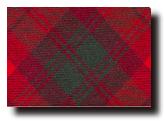 There was no prohibition on clerics in the Celtic Christian church marrying and so it came about that "mac an aba" - son of the abbot - became established in Glendochart in Perthshire. The progenitor of the clan is traditionally the abbot of Glendochart and Strathearn who was a younger son of Kenneth Macalpin. Since the abbots were hereditary, the first MacNab chiefs were also the abbots of the monastery.
There was no prohibition on clerics in the Celtic Christian church marrying and so it came about that "mac an aba" - son of the abbot - became established in Glendochart in Perthshire. The progenitor of the clan is traditionally the abbot of Glendochart and Strathearn who was a younger son of Kenneth Macalpin. Since the abbots were hereditary, the first MacNab chiefs were also the abbots of the monastery.
The MacNabs supported the Comyns in the Wars of Independence (Angus MacNab was a brother-in-law of John Comyn who was murdered by Robert the Bruce in 1306) and their lands were confiscated by The Bruce. However, the barony of Bovain in Glendochart was restored to Gilbert MacNab by Bruce's son, King David II, in 1336. In 1954, when the Lord Lyon was looking at the succession of MacNab chiefs he named Gilbert as the first undisputed chief though there had probably been many generations before him.
In the 16th century the MacNabs expanded, stretching from Tyndrum in Perthshire to Dalmally in Argyll. The clan castle was at Eilean Ran on an island on the river Lochay. But by the end of the century all the land had been mortgaged to the Campbells of Glenorchy and they became a "broken" or landless clan.
In 1612, a party of MacNabs, led by "Smooth John" MacNab, carried a boat over the hills from Loch Tay to Loch Earn so that they could attack and slaughter the MacNeishes. The mountainous terrain suggests that this would be impossible but in 1965 a group of Black Watch territorials showed that it was feasible. "Smooth John" supported Montrose against the Campbells. At one point he was captured and managed to escape on the eve of his execution but died later in 1653 after surviving the Battle of Worcester in the Civil War. In the see-saw of power, the MacNabs lost their lands to the Campbells at that time - but regained them again after the Restoration in 1660.
The MacNab chiefs did not involve the clan in the Jacobite Uprisings of 1715 and 1745 but the 15th chief was a major in the Hanoverian army and was captured at the Battle of Prestonpans in 1745.
At the turn of the 18th century, Sir Henry Raeburn painted a famous portrait of the "The MacNab" a Chief of the clan, dressed as a colonel of the Breadalbane Volunteers. It shows a stern, forceful character, as befits a chief of a proud clan. But although he amassed considerable estates during his lifetime, he also consumed large quantities of whisky and he died in 1816 owing a large sum of money. Although he had many illegitimate children, he left no direct heir. His nephew Archibald tried to escape his creditors by fleeing to Ontario in Canada where he attempted, unsuccessfully, to set up a clan system amongst the many MacNabs who had already emigrated there. Later, a member of the clan, Sir Allan Napier MacNab, became Prime Minister of Upper Canada.
Some MacNab lands were recovered in the 20th century and the present chief lives in Kinnell House.
The MacNab clan motto is "Timor omnis abesto" which means "Let fear be far from all".
Surnames regarded as septs (sub-branch) of the MacNab clan include Abbot, Abbotson and Gilfillan.



